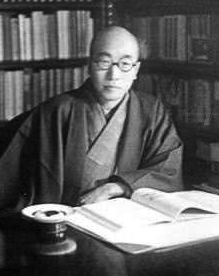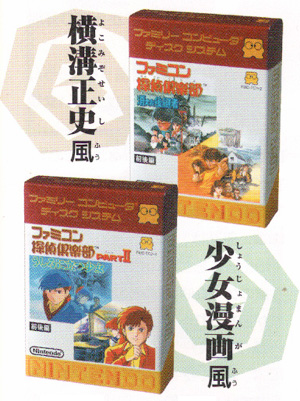Special articles, columns and features exclusive to the MDb.
Famicom Disk System:
The More You Play It, the More You'll Want to Play! [Disk 2]
Introduction | Part 1 | Part 2 | Part 3 | Part 4 | Part 5 | Part 6 | Part 7 | Part 8
FAMITAN'S ORIGINAL TITLE WAS CORPSE VILLAGE?Well, awhile ago, in the Famitan (Famicom Tantei Club) discussion, you said regarding The Missing Heir, "We made The Girl who Stands Behind because there were things left unfinished" (previous issue). What specifically did you feel had been left unfinished?Sakamoto: With the original Famitan, the protagonist had amnesia, and though the setup was sketchy, initially there wasn't too much of a story. Although we created the story to The Missing Heir, at any rate, its contents became disconnected from reality, and it wasn't glamorous. It was "Your grandmother, died," "Your father died," or "Your mother died." (Laughs) In those days, I really liked horror; the first issue of a horror comic magazine called Halloween was just released, and I also really liked ghost stories about high school. Because of that, ideas blossomed, and I wanted to make a horror story set at an academy. And in that situation, I could show a little girl wearing a sailor outfit! (Laughs) (Laughs)Sakamoto: Originally, The Missing Heir had the taste of Seishi Yokomizo's work, but I think The Girl who Stands Behind had a shojo manga (young girls' manga) style. |
|
I see. Up to that point, Sakamoto-san, you had read only two suspense novels by Seishi Yokomizo*, right?*Seishi Yokomizo: Mystery author who created the great detective Kosuke Kindaichi. By 1976, his series of works, The Inugami Clan, The Village of Eight Graves, The Devil Comes to Play His Flute, and others, had been turned into movies, as well as best-selling novels. Sakamoto: No, no, it was a novel-and-a-half! (Laughs) I was partway through reading The Song of the Demon's Temari Ball when I got a nosebleed... A drop of blood fell on the book, and because of that, I got depressed and stopped reading. However, since I was a senior high school student at the time, I was young. (Laughs) Ah ha ha ha! (Smiles)Osawa: As for mystery novels, I also like them, and although we did the scenario work together, Sakamoto was very interested in writing it. Since I didn't know much regarding mystery novels, that's probably why I keep watching the "something or other Hot Springs Murder Case"* drama that runs for two hours! (Laughs) *Probably The Mystery of the Murderer of the Hot Springs Proprietress, a serial TV drama that began in 1994 and is in its 22nd season as of May 2011. Sakamoto: I haven't watched much of that show! (Laughs) |
|
|
Yamamoto: That scenario Sakamoto wrote, I still have it. Huh, really? By all means, please let me show it in the magazine!Sakamoto: It's alright if you pull out your camera and take a picture. The handwriting's terrible! (Laughs) Yamamoto: In those days, since there weren't any word processors, it was written entirely in Sakamoto's handwriting. Sakamoto: The original title was Corpse Village. I showed the proposal to my boss [Gumpei Yokoi or Makoto Kanoh], and he said, "Hmm, so this game is Fart Village?"* I never forgot it! (Laughs) *The kanji for "corpses" (屍) is very similar to the kanji for "farts" (屁). Everyone: (Laughs uproariously) Sakamoto: Well, that's how bad I was at writing! (Laughs) Osawa: However, Fart Village was much easier to understand. (Laughs) The main point is, with the title that became Famicom Tantei Club, initially the instructions from above were, "Make a game with the title Famicom Youth Detective Group." It was just the title! (Laughs) Moreover, whatever it was you came up with, they wouldn't say anything. |
|
Regarding Sakamoto-san and Osawa-san, who oversaw the scenario, of course while you liked Edogawa Rampo*, the game you made wasn't like his novels.*Edogawa Rampo: Mystery author of the early 20th Century who created the detective Kogoro Akechi, who stars in a series of detective novels for young adults. The first novel, The D Slope Murder Case was written in 1925, and Rampo continued writing Akechi novels well into the 1950s. -Ed. Osawa: I liked Seishi Yokomizo. When I was in senior high school, Kosuke Kindaichi's The Inugami Clan* had just been made into a movie, and I also had started to read the series. So, I told the package illustrator, "I want something like a Seishi Yokomizo movie poster by Toho," and although I begged him to draw it like that, the quality wasn't very good. But in those days, I thought, "Can't they draw it for me closer to what I requested?" *Kosuke Kindaichi: Famous detective created by Yokomizo Seishi. Kindaichi's first case, The Case of the Honjin Murderer, is regarded as one of the greatest Japanese detective novels. The Inugami Clan, directed by Kon Ichikawa, is considered one of the finest supernatural suspense films in Japan. What more could you expect from an author who has an esteemed literary award named after him? -Ed. Was it drawn by someone inside the company?Osawa: No, we requested it from an outside company. Sakamoto: I though that picture was pretty awful. Osawa: (Pointing to the box for The Girl who Stands Behind) Because of that, we got this picture. The package style itself also changed to shojo manga based on Seishi Yokomizo's style too, didn't it?Osawa: I drew the rough sketch of The Girl who Stands Behind. I also did the layout. It was completed by a skilled artist. |
Introduction | Part 1 | Part 2 | Part 3 | Part 4 | Part 5 | Part 6 | Part 7 | Part 8














